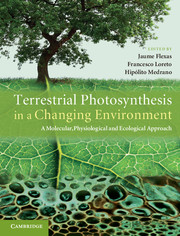 Terrestrial Photosynthesis in a Changing Environment
Terrestrial Photosynthesis in a Changing Environment Book contents
- Frontmatter
- Contents
- List of contributors
- Preface
- Acknowledgements
- List of abbreviations
- 1 Terrestrial photosynthesis in a changing environment
- Part I Photosynthesis
- Part II Measuring photosynthesis
- Part III Photosynthetic response to single environmental factors
- 16 Photosynthetic responses to radiation
- 17 Photosynthetic responses to increased CO2 and air pollutants
- 18 Response of photosynthesis to low temperature
- 19 Photosynthetic responses to high temperature
- 20 Photosynthesis under water deficits, flooding and salinity
- 21 Photosynthetic responses to nutrient deprivation and toxicities
- 22 Photosynthetic responses to biotic stress
- Part IV Photosynthesis in time
- Part V Photosynthesis in space
- Part VI Photosynthesis in a global context
- References
- Index
21 - Photosynthetic responses to nutrient deprivation and toxicities
Published online by Cambridge University Press: 05 March 2013
- Frontmatter
- Contents
- List of contributors
- Preface
- Acknowledgements
- List of abbreviations
- 1 Terrestrial photosynthesis in a changing environment
- Part I Photosynthesis
- Part II Measuring photosynthesis
- Part III Photosynthetic response to single environmental factors
- 16 Photosynthetic responses to radiation
- 17 Photosynthetic responses to increased CO2 and air pollutants
- 18 Response of photosynthesis to low temperature
- 19 Photosynthetic responses to high temperature
- 20 Photosynthesis under water deficits, flooding and salinity
- 21 Photosynthetic responses to nutrient deprivation and toxicities
- 22 Photosynthetic responses to biotic stress
- Part IV Photosynthesis in time
- Part V Photosynthesis in space
- Part VI Photosynthesis in a global context
- References
- Index
Summary
INTRODUCTION
General aspects of plant responses to nutrients
Plant growth requires the incorporation of elements (nutrients) into plant organs. In non-woody plants, 15–20% of fresh weight is made from such elements, the rest being water. There are two criteria to consider an element as essential. First, an element is essential if a plant cannot complete its lifecycle (till viable seeds) in its absence. Second, an element is essential if necessary to synthesise molecules that cannot be replaced by other element(s) (for example, N in proteins). In natural ecosystems, soil-nutrient availability is rather heterogeneous, and plants may adapt their growth to nutrients taken up by roots exploring a determined soil volume. In agricultural areas, the situation is different. Lack of or excess nutrients are frequent, owing to soil characteristics (which may immobilise nutrients) or to growers’ applications, respectively.
An idealised representation of plant growth-rate response to availability of any given nutrient would show three different zones: namely (1) deficient; (2) adequate; and (3) toxic. In the range of low nutrient concentrations (deficient zone), growth and the plant nutrient concentration markedly increase as soil nutrient availability increases. As availability increases further the so-called critical concentration is reached. This corresponds to the lowest concentration of nutrient in plant tissue that gives almost maximal growth. Above this point, increases in soil nutrient availability do not affect growth (adequate zone). In the adequate zone, there is a plentiful supply of nutrients, and the excess nutrients may be taken up and stored in leaf vacuoles, special storage proteins in bark or uptake may be downregulated so as to avoid taking up excess nutrients. This zone is fairly wide for macronutrients, but narrower for micronutrients. If nutrient availability increases more and uptake cannot be controlled, toxicity appears and growth is reduced (toxic zone).
- Type
- Chapter
- Information
- Terrestrial Photosynthesis in a Changing EnvironmentA Molecular, Physiological, and Ecological Approach, pp. 312 - 330Publisher: Cambridge University PressPrint publication year: 2012
- 3
- Cited by
